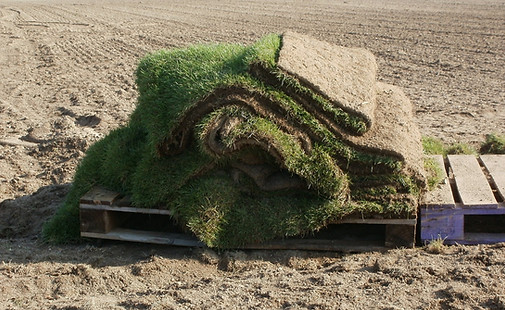
WATERING
Right Away
It is essential to begin watering new turfgrass sod within a half hour after it is laid on the soil. Apply at least 1 in. of water so that the soil beneath the turf is very wet. Ideally, the soil 3 to 4 in. below the surface will be moist.

Watering Tip #1:
Pull back a corner of the turf and push a screwdriver or other sharp tool into the soil. It should push in easily and have moisture along the first 3 or 4 in. or you need to apply more water.
Watering Tip #2:
Make absolutely certain that water is getting to all areas of your new lawn, regardless of the type of sprinkling system you use. Corners and edges are easily missed by many sprinklers and are particularly vulnerable to drying out faster than the center portion of your new lawn. Also, areas near buildings drying out faster because of reflected heat and may require more water.
Watering Tip #3:
Runoff may occur on some soils and sloped areas before the soil is adequately moist. To conserve water and insure adequate soak-in, turn off the water when runoff begins, wait 30 minutes to an hour and restart the watering on the same area, repeating as needed.

First Two Weeks
For the next two weeks (or until the turf is well rooted), keep the below turf soil surface moist with daily (or more frequent) watering of approximately one-quarter inch each. Especially hot, dry or windy periods will necessitate increased watering amounts and frequency.
Watering Tip #4:
As the turf starts to knit it's new roots into the soil, it will be difficult, impossible and/or harmful to pull back a corner to check beneath the turf (Watering Tip #1), but you can still use a sharp tool to check moisture depth by pushing it through the turf into the soil.
Watering Tip #5:
Water as early in the morning as possible to take advantage of the daily start of the grass's normal growing cycle, usually lower wind speeds and considerably less loss of water because of high temperature evaporation.
Watering Tip #6:
If the temperature approached 100° F (37° C), or if high winds are constant for more than half of the day, reduce the temperature of the turf surface by lightly sprinkling the area. This sprinkling does not replace the need for longer, deeper watering, which will become even more critical to continue during adverse weather conditions.
Remainder of Season
During the remainder of the growing season, most lawns will do very well with a maximum total of one inch of water a week, coming either from rain or applied water. Soil conditions may dictate that the amount be applied in two settings, approximately two or three days apart. This amount of water, properly applied, is all that is required for the health of the grass, providing it is applied evenly and saturates the underlying soil to a depth of 4 to 6 in.

Watering Tip #7:
Infrequent and deep watering is prefered to frequent and shallow watering because the roots will only grow as deeply as their most frequently available water supply. Deeply rooted grass has a larger "soil-water bank" to draw moisture from and this will help the grass survive drought and hot weather that rapidly dries out the upper soil layer.
Things to Remember
Proper watering techniques are a critical aspect of lawn watering, equal in importance to the issues of when to water and how much to water. Here are several key factors to proper technique:
Avoid hand sprinkling because it cannot provide the necessary uniformity as most people do not have the patience, time or "eye" to adequately measure what is being applied across any larger areas of lawn. The only possible exception to this guideline would be the need to syringe the surface of the grass to cool it, or to provide additional water near buildings or other heat-reflecting surfaces.
Understand the advantages of different sprinkler designs, because each type has its advantages and disadvantages and its proper use will be determined by the type of sprinkler you select.
In-Ground Systems require professional design and installation and they require routine adjustments and regular maintenance to be most effective and efficient. The greatest mistake made with most in-ground systems is the "set it and forget it" philosophy that fails to account for the changing seasonal water requirements to maximize turf grown or even allowing the system to operate during or following a multi-inch rain storm. Another frequent problem is when heads get out of alignment and apply water to the sidewalk, street or house-siding, rather than to the lawn.
Hose-End Sprinklers range in complexity, cost and durability, but are highly portable and can provide uniform and consistent coverage, when properly placed on the yard and adequately maintained.
Sprinklers that do not throw the water high into the air are usually more efficient because prevailing winds are less disruptive of distribution patterns, the potential for evaporation loss is reduced and trees, shrubs and other plants do not block the pattern (or are very noticeable if they do).
Several times during the growing/watering season, routine maintenance to check for blocked outlets, leaking or missing gaskets, or mis-aligned sprinkler heads is important, regardless of the sprinkler design.
